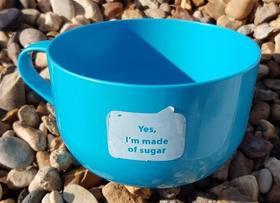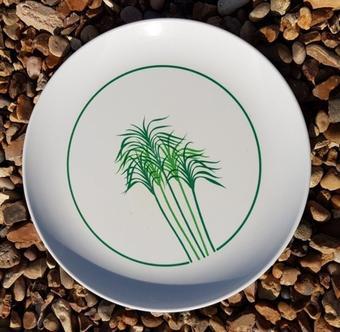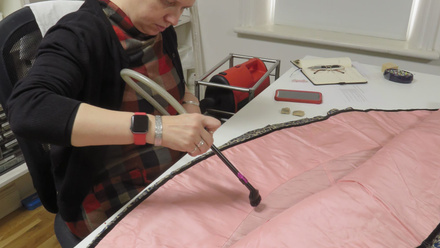My Museum of Plastics: Tableware tales
The Museums and conservation labs around the country are closed due to the Covid -19 pandemic and we are all getting used to this new world of working from home. Working from home does not come naturally to the conservators (like me) who are used to conserving, handling and investigating objects at work. Now we only have the objects in our homes and, at least in my case, there’s not as many and they are not as old as those at the Museum of London where I work. However, they can still be interesting. I decided to investigate a few of the modern materials around my home. I might learn something new about the materials they are made from and it will be fun to try and predict how they will deteriorate in the future (just like if they were in a museum collection). Here’s three of my favourites.

The Grapefruit knife was an essential kitchen item at home in the late 70’s and 80’s (back when we used to have a mountain of sugar heaped on the grapefruit- alas those times are gone). I suspect my mum got it free with the purchase of a bag of Jaffa grapefruit in the late 60’s.
It is the only object at home that is displaying signs of plastic deterioration. The handle is white, opaque, it has faint yellow discolouration and there are small cracks all over the surface. There’s nothing on the knife that suggests what the handle is made from.
I found some identical knives on the internet for sale: “Vintage”, “Mid Century”, made from “Bakelite” they said. I am not at all convinced this handle is Bakelite, Bakelite is very stable, and unlikely to deteriorate in this way. I think it is more likely to be Cellulose Nitrate (CN) or Cellulose acetate (CA). These two semi-synthetic polymers were extensively used for cutlery The plastic does not appear to have caused the metal to corrode, and does not have any droplets of acid on the surface, but as it is an item that sees occasional use any surface droplets is likely to have been washed away.
For arguments sake I will presume that the knife handle is Cellulose Acetate, I took a little sample and tried burning it, it flared up bright light yellow. Cellulose acetate is flammable (although not as much as Cellulose nitrate). Another thing that is against this being cellulose Nitrate is the date, if it’s from the 60’s it’s more likely to be Cellulose Acetate as this polymer was in common use for cutlery for longer. Cellulose Nitrate went out of favour earlier because of its flammability.
If it is cellulose nitrate or acetate it will deteriorate steadily. Polymer break-down has already started, and this will to carry on. Acidic vapours from the grapefruit knife may attack other things in my cutlery drawer, (this is maybe more the case in a Museum store cutlery drawer than in mine).
Since this is at home I welcome the fact that the handle will not last forever. It will break down into the materials it is made from: cellulose fibres, nitric acid, sulphuric acid, water, alcohol, colorants and fillers. I think it’s great that it does not break down into micro plastics and hangs around for much longer than necessary. If it had been part of the museum’s collection I might have felt differently.

I got this cup from the Science Museum shop about 5 years ago, intrigued by the claim that it was made from Sugar. One lovely thing about modern plastics is that they will often tell you what they are made from, which makes life so much easier when trying to conserve objects (at work) or dispose of objects (at home). Not that I will dispose of this cup as there is absolutely nothing wrong with it but we all have had that problem, haven’t we? Where to dispose of your plastics responsibly when something breaks?
The triangle at the base of the cup has a 7 in it, the number means “other”, but the manufacturer has helpfully indicated in big letters that it is in fact Poly Lactic Acid, PLA. This plastic is not made from petroleum, but, as the label indicates, it uses sugarcane as raw material.
In terms of being environmentally friendly it is made from a renewable resource which is great, but one might ask if it is responsible to use what could essentially have been food for anything else than feeding people.
PLA is a thermoplastic and can be recycled (melted) into another shape, but this is dependent on someone collecting a lot of this one material, and PLA is not commonly recycled in the UK, as there’s not enough of it in use. However collecting PLA cups for recycling can be successfully done in closed circuits, like festivals.
Another environmental claim on the base of the cup is that it is compostable, not all PLA is compostable, so this is a bonus. However most PLA needs a commercial composter, and will not necessarily deteriorate in my home composting bin.
So this cup is maybe not as environmentally friendly as it seems, but to me the main thing about the plastics in my home is that they are functional for a long time. The more times I use it the more environmentally friendly it is.

My third object is a Melamine plate, also helpfully identified by the manufacturers on the underside. I have had this plate (it is part of a set) for over 15 years, and it is in regular use, especially during the summer months. It was second hand when I got it in Italy, and is still in very good condition. It has accompanied me on many adventures.
Melamine became widely available after the Second World War and was used extensively for tableware, because of its seemingly unbreakable qualities. It is still in use for picnic ware, and was also used for ashtrays because of its non-flammable properties. It can be found in a wide variety of shapes and colours.
Melamine is a thermosetting resin, and cannot be recycled by melting it into a new plastic. It can be ground down into granules and used as a filler in other plastic products. Like PLA it has 7 as the resin identification code.
A melamine plate will last for a while, it is a very stable plastic in a museum collection (and home), although the colours may fade if exposed to high light levels, it may also be stained by foods, but this has not happened to mine yet.
In my spare time I often pick up rubbish. I spend a lot of time on and by the sea, and I worry about single use plastics, and their impact on marine life. At home I celebrate autocatalytic self destruction in plastics and biodegradability, but not so much in my work as a conservator. In a museum I’d prefer Melamine, but at home I’d like more Cellulose Acetate.






